“Did you know that cottage cheese packs nearly 25g of protein per cup?” Whether you’re hustling through a busy morning or following a high-protein meal plan, a cottage cheese breakfast bowl is the unsung hero of effortless nutrition.
Hi, I’m excited to share my go-to guide on building satisfying, nutrient-rich breakfast bowls using cottage cheese. These bowls are incredibly versatile — think sweet berries and honey, or savory avocado and eggs. We’ll walk through six delicious ways to enjoy them, meal prep hacks, budget tips, and even ideas for weight loss and clean eating. You’ll find this guide tasty, helpful, and Pinterest-worthy too! Let’s dig in — your mornings are about to get a protein-packed makeover!
Read: 10 Easy Cottage Cheese Recipes for Weight Loss You’ll Crave in 2025
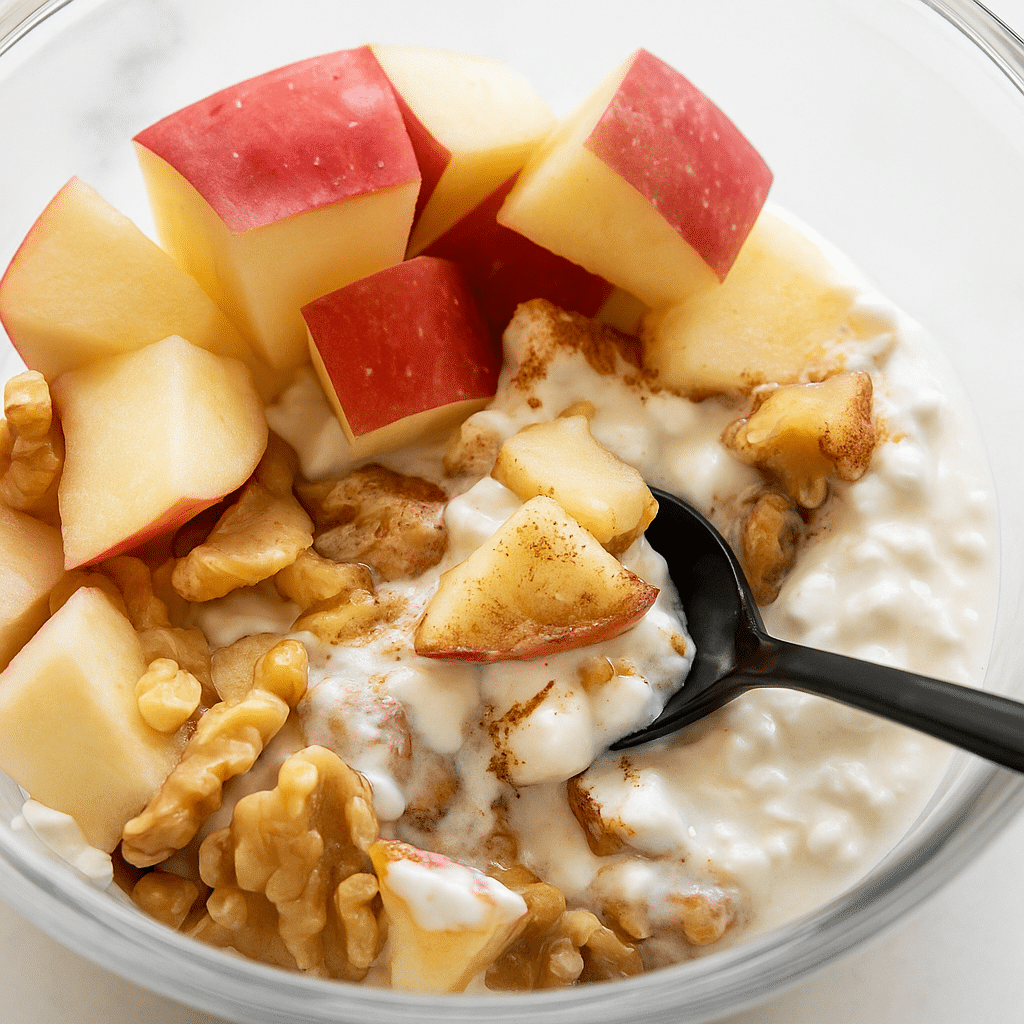
Table of Contents
Table of Contents
Why Cottage Cheese Is the Ultimate Breakfast Powerhouse
Alright, confession time — I used to think a cottage cheese breakfast bowl was something only gym rats or old-school dieters ate. But fast forward a few chaotic mornings, a couple of failed smoothie attempts, and me realizing I needed more protein, and suddenly… I’m hooked.
Read: Viral Cottage Cheese Wrap Recipe (2025): High-Protein, Low-Carb & TikTok Famous!
It’s Packed with Protein — And It’s Real Filling
Look, I’ve tried a lot of quick breakfasts. Toast, yogurt, even overnight oats with chia seeds. But nothing kept me full like a good old cottage cheese breakfast bowl. One cup? That’s 25 grams of protein — more than two eggs and most of the yogurts out there. It hits different when you’re trying to power through a stacked morning.
I usually toss in some berries, a sprinkle of almonds, and bam — I don’t get snacky until lunchtime. Total game-changer. Especially when you’re trying to not crash by 10 a.m.
Sneaky Source of Calcium and B12
You’d think dairy is just for calcium, right? Wrong. My cottage cheese breakfast bowl also gives me a solid hit of vitamin B12 — which, fun fact, is something I didn’t know I needed more of until my hair started falling out (yikes).
That combo of calcium and B12 makes it a solid pick for anyone — not just us 30-somethings trying to eat like adults. It’s like a little nutrition bomb hiding in a tub of curds.
Better Than Yogurt, Eggs, or Oatmeal?
Okay, hot take: cottage cheese breakfast bowls beat Greek yogurt bowls. I said what I said.
Yogurt? Great, but even the “healthy” ones are sugary. Eggs? I love ’em, but they need cooking. Oatmeal? Comfort food, sure, but I always end up hungry an hour later. My cottage cheese breakfast bowl? No sugar crash, no cooking, and full until lunch. Plus you can go sweet or savory with it — cinnamon apples one day, avocado and egg the next.
Read: Savory Cottage Cheese Pancakes Recipe You’ll Love in 2025
Perfect for Meal Prep and Weight Loss
Three words: zero-effort prep.
On Sundays, I make 3–4 cottage cheese breakfast bowls, toss in fruit, nuts, or whatever’s in the fridge. They hold up great in the fridge, and I don’t have to think about breakfast all week. Also, they’re low-carb, high-protein, and totally budget-friendly. I once calculated a full bowl at under $1.75 — can’t beat that.
If you’re trying to lose weight without feeling miserable, these bowls are chef’s kiss.
Who Should Try This?
Honestly? If you’re reading this, probably you.
- Busy moms: No cooking. No whining from the kids.
- Fitness peeps: Protein without protein powder.
- College students: Cheap, no heat required, no dishes.
- Anyone who hates breakfast but knows skipping it never works out.
Seriously, a cottage cheese breakfast bowl might not be glamorous, but it’s reliable. Like your favorite hoodie — comfy, unfussy, and always gets the job done.
Print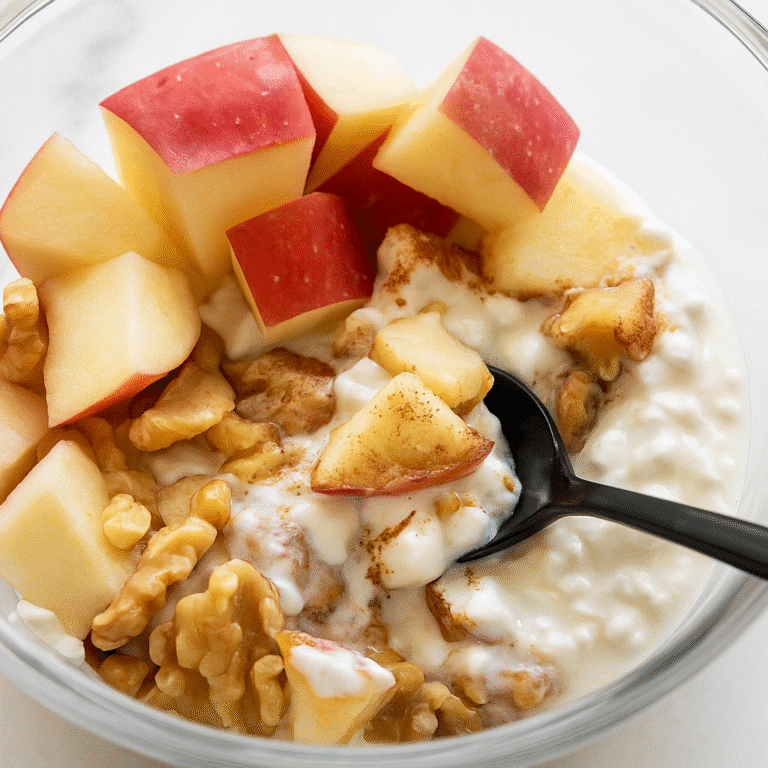
Apple Cinnamon Cottage Cheese Breakfast Bowl
Protein-packed creamy cottage cheese, sweet and juicy apples, warm cinnamon, and crunchy walnuts make a delightful and healthy no-cook breakfast.
- Total Time: 5 minutes
- Yield: 1 bowl 1x
Ingredients
- ½ cup 2% cottage cheese
- ½ apple, chopped
- 1 Tbsp chopped walnuts
- 1 Tbsp maple syrup
- 1 pinch cinnamon
Instructions
- Add all the ingredients to a bowl or container.
- Enjoy immediately, or refrigerate in an air-tight container up to four days.
Notes
For best texture, use freshly chopped apples and stir just before eating. This bowl makes a perfect grab-and-go meal prep option.
- Prep Time: 5 minutes
- Cook Time: 0 minutes
- Category: Breakfast
- Method: No-Cook
- Cuisine: American
Nutrition
- Serving Size: 1 bowl
- Calories: 242
- Sugar: 17g
- Sodium: 356.5mg
- Fat: 7.7g
- Saturated Fat: 2.5g
- Unsaturated Fat: 5.2g
- Trans Fat: 0g
- Carbohydrates: 31.6g
- Fiber: 2.7g
- Protein: 13.6g
- Cholesterol: 10mg
How to Build a Cottage Cheese Breakfast Bowl (Base Formula)
I used to completely overthink breakfast. Like, should I go sweet? Savory? Am I eating enough protein? Too much sugar? It was exhausting. Then I figured out this super simple formula for building a solid cottage cheese breakfast bowl — and everything just clicked.
Turns out, there’s a reason I kept reaching for cottage cheese. It’s quick, customizable, and way more satisfying than half the “healthy” options I used to try.
Read: Cucumber Cottage Cheese Bites (2025): A Fresh, High-Protein Snack You’ll Love
Step 1: Start with the Base
The foundation of any good cottage cheese breakfast bowl is — surprise — the cottage cheese itself. I usually go with about ½ to ¾ cup. It’s enough to feel full but not weighed down. If you’re tracking macros or just want a solid protein punch, a full cup gives around 25g of protein, which is perfect.
For the base, I stick with full-fat or 2% cottage cheese. The fat helps with that creamy texture and keeps me fuller longer. Non-fat works too, but I find it’s a bit… chalky. Been there, regretted that.
Step 2: Choose Your Add-Ins
Now comes the fun part. This is where your cottage cheese breakfast bowl really starts to reflect your mood. If I’m craving something sweet, I go for:
- Fresh berries
- Sliced banana
- A drizzle of honey
- Cinnamon and chia seeds
But if I’m leaning savory, I reach for:
- Cherry tomatoes
- Sliced avocado
- Hard-boiled egg
- A dash of everything bagel seasoning
Mixing too many flavors? Yeah, I’ve done that. It gets weird fast. Stick to two or three core add-ins to keep it balanced.
Step 3: Top It Off
This part gets overlooked, but toppings make or break a cottage cheese breakfast bowl. A handful of granola gives crunch. Nuts or seeds add healthy fats and texture. For savory bowls, I’ve even used a little hot sauce or crumbled turkey bacon.
The trick is: don’t overdo it. Keep the toppings light — they’re there to complement, not overwhelm.
Sweet vs. Savory Ratios
Here’s my rule of thumb: for sweet bowls, go 60% fruit, 40% cheese. For savory, I keep it closer to 50/50 — especially if I’m adding heavier stuff like eggs or avocado.
You don’t want your cottage cheese breakfast bowl to turn into a dessert (or worse, a flavor war). Keep it simple, and you’ll be golden.
Read: Cottage Cheese Stuffed Peppers Recipe (2025): High-Protein, Low-Carb & Delicious!
Storage Tips and Best Containers
I’m all about prepping ahead. I use 8 oz glass containers with lids. They’re stackable, don’t stain, and hold the perfect amount. If you’re making bowls for a few days, keep the wet stuff (like fruit or tomatoes) separate until serving — otherwise, things get soggy.
I’ve also tried storing the whole bowl with everything mixed in… yeah, not my best move. The textures go mushy fast. Keep your ingredients layered or stored separately when prepping.
Once you’ve nailed your formula, a cottage cheese breakfast bowl goes from “eh, I’ll eat it” to “oh wow, I actually look forward to this.” And that’s coming from someone who used to skip breakfast completely.

6 Easy Cottage Cheese Breakfast Bowl Recipes (Sweet & Savory)
If you’re like me, breakfast needs to check four boxes: fast, filling, cheap, and actually tasty. That’s how I landed on the cottage cheese breakfast bowl — and not just one kind. I’ve tested at least twenty flavor combos, but these six? These are the ones I make over and over again.
Three are sweet (because sometimes I want it to feel like dessert), and three are savory (when I’m craving something hearty). Each one takes less than five minutes to make, and I’ll break down the ingredients, prep tips, and even a few flavor hacks I’ve picked up along the way.
Read: Cottage Cheese Tuna Salad Recipe (2025) – High-Protein, Low-Carb, and Delicious!
1. Berry Almond Bowl (Sweet)
- Ingredients: ½ cup cottage cheese, ⅓ cup mixed berries, 1 tbsp sliced almonds, drizzle of honey
- Prep time: 2 minutes
- Cost per serving: Around $1.50
- Storage tip: Add berries right before eating to avoid sogginess
I usually use frozen berries when fresh ones are pricey — let them thaw for 15 minutes and they’re perfect. A great go-to when I need a quick cottage cheese breakfast bowl that feels refreshing.
2. Apple Cinnamon Bowl (Sweet)
- Ingredients: ½ cup cottage cheese, ½ chopped apple, dash of cinnamon, sprinkle of granola
- Prep time: 3 minutes
- Cost per serving: About $1.30
- Storage tip: Apples brown, so toss them in lemon juice if prepping ahead
This one reminds me of apple pie, minus the sugar crash. If I’m in a cozy mood, I warm the apples a little — makes the bowl feel like comfort food.
3. Peanut Butter & Banana Bowl (Sweet)
- Ingredients: ½ cup cottage cheese, ½ sliced banana, 1 tbsp natural peanut butter
- Prep time: 2 minutes
- Cost per serving: Roughly $1.40
- Storage tip: Assemble fresh — bananas don’t store well
This is my post-workout cottage cheese breakfast bowl. The banana gives quick carbs, peanut butter brings in the healthy fats, and the cottage cheese does its protein thing.
4. Avocado & Egg Bowl (Savory)
- Ingredients: ½ cup cottage cheese, ¼ sliced avocado, 1 boiled egg, sprinkle of chili flakes
- Prep time: 5 minutes (if eggs are prepped)
- Cost per serving: Around $1.80
- Storage tip: Store separately and assemble fresh
This bowl hits hard on days I wake up starving. The combo of creamy cottage cheese and avocado? Kind of magic. I usually add hot sauce too, because I like pain apparently.
5. Mediterranean Bowl (Savory)
- Ingredients: ½ cup cottage cheese, chopped cucumber, cherry tomatoes, olives, drizzle of olive oil
- Prep time: 4 minutes
- Cost per serving: About $2.00
- Storage tip: Great for meal prep — just keep veggies dry
This one makes me feel like I’m eating something fancy, even if I’m standing at the counter in my pajamas. Add oregano if you want that extra Greek flair.
6. Tex-Mex Bowl (Savory)
- Ingredients: ½ cup cottage cheese, black beans, salsa, chopped green onion, pinch of cumin
- Prep time: 3 minutes
- Cost per serving: $1.60
- Storage tip: Mix right before serving — salsa gets watery
Honestly, this cottage cheese breakfast bowl might be my favorite. It’s like eating nachos for breakfast… without actually eating nachos. Sometimes I throw in crushed tortilla chips if I’m feeling reckless.
Read: Cottage Cheese Smoothie Recipe (2025) – High-Protein, Creamy & Delicious!
You don’t need a lot of ingredients, time, or cash to make any of these bowls. Just cottage cheese, a few pantry items, and a little experimenting. Once you find your go-to combos, breakfast gets way easier — and way better.
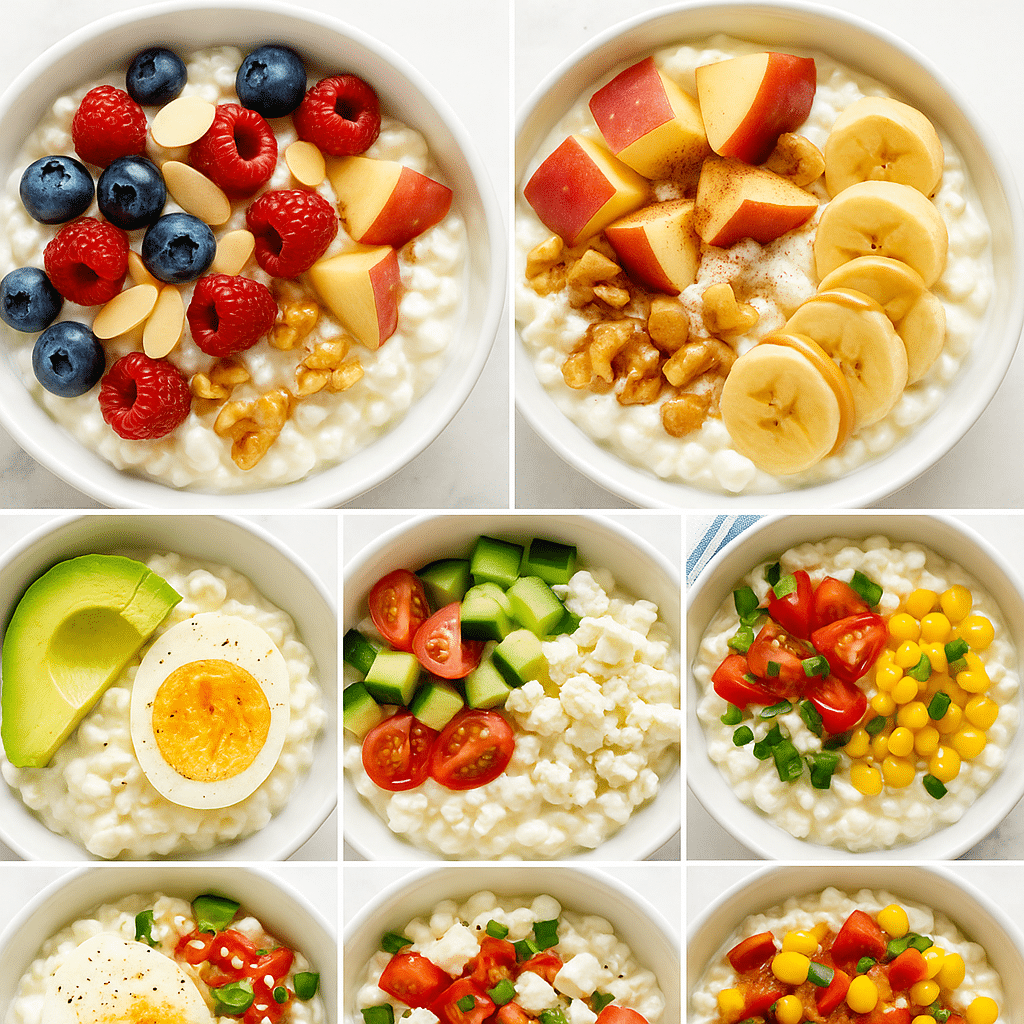
Meal Prep & Storage Tips for Busy Mornings
Okay, so let’s talk about mornings. Mine? Usually chaos. Between trying to find a clean pair of socks and packing a lunch that doesn’t involve Goldfish crackers, breakfast is almost always an afterthought. That’s why meal prepping cottage cheese breakfast bowls saved my mornings — and honestly, my sanity.
It took a few trial runs (and some gross, soggy fruit incidents), but I’ve nailed down a system that actually works.
Read: Zoodle Noodle Spaghetti Bowl (Easy 30-Minute Dinner Idea for 2025)
Batch the Ingredients, Not the Whole Bowl
At first, I tried prepping full bowls ahead of time. Cottage cheese, fruit, nuts — all mixed together. Sounded smart. Until day two, when the berries were mushy, and the almonds went soft. Not great.
Now I prep everything in parts. I scoop cottage cheese into individual containers (½ to ¾ cup each), then keep toppings separate in little baggies or silicone cups. In the morning, I just dump in what I want and go. That’s the move.
How Long Do They Last?
Straight cottage cheese? It’ll stay good in the fridge up to 5 days, as long as it’s sealed tight. But once you start adding stuff like fruit or cooked eggs, that changes.
Here’s what I’ve found works best:
- Fruit: Add fresh each morning unless you’re using firm stuff like apples or grapes
- Nuts/granola: Add same day or store in a dry container
- Savory add-ins: Eggs, avocado, salsa — make fresh or add day-of
Honestly, if your cottage cheese breakfast bowl sits fully assembled for more than 2 days, the texture starts to go sideways.
Best Containers for the Job
Tried a lot, settled on two:
- Glass 8 oz jars with screw-on lids — perfect size, no smell transfer
- Divided meal prep containers — especially for keeping wet and dry stuff apart
Plastic’s fine in a pinch, but it tends to stain and warp over time. I once melted a lid trying to microwave something and nearly ruined the whole batch. Lesson learned.
Read: Cottage Cheese Egg Muffins Recipe (2025): High-Protein, Meal-Prep Friendly Breakfast Bites
Grab-and-Go Hacks
If your mornings are pure madness like mine, prep 2–3 cottage cheese breakfast bowls on Sunday. I stack them in the fridge, toppings on top or on the side, and they’re ready to grab in the rush.
I’ve also done “fridge bins” with pre-packed dry toppings (like nuts or granola), and just pair that with a container of cottage cheese each morning. It’s not fancy, but it works.
For work or school? Toss the container in a lunch bag with a cold pack. It’ll stay chilled until you get hungry around 10.
Meal prepping doesn’t have to be this big Pinterest project. It just needs to work. Once you’ve got a few supplies and a routine, your cottage cheese breakfast bowl practically makes itself — and that’s one less thing to stress about at 7 a.m.
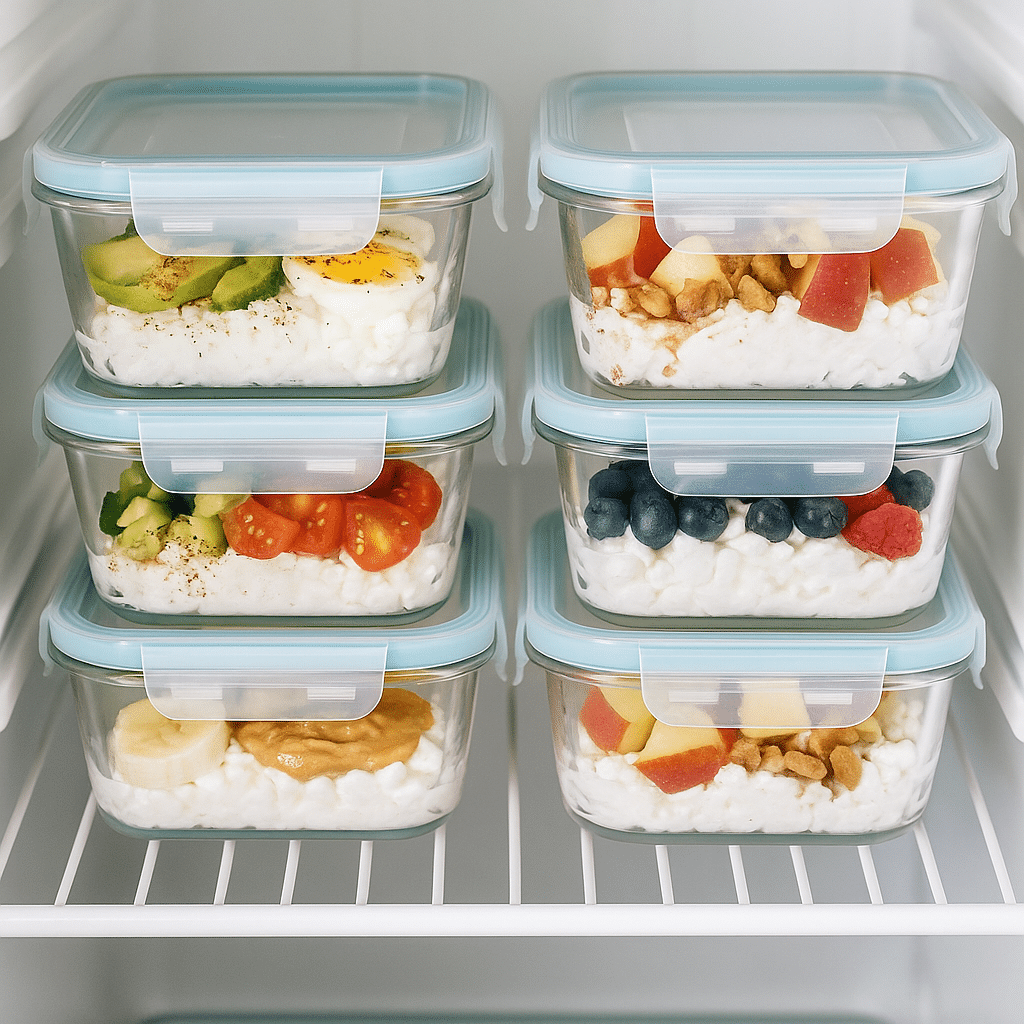
Cottage Cheese Bowl Variations for Different Diets
One of the things I love most about a cottage cheese breakfast bowl is how dang flexible it is. You’ve got one basic ingredient, and from there it’s like a blank canvas. Whatever your eating style — keto, vegetarian, gluten-free, low-sodium — you can make it work without needing 17 ingredients or a trip to Whole Foods.
When I started tracking macros for a low-carb phase, I thought I’d have to ditch breakfast bowls entirely. Turns out, I just needed to tweak a few things. Here’s what I’ve learned from messing around with different versions — some good, some… not so good.
Read: Cinnamon Apple Cottage Cheese Bowl (2025): A High-Protein Breakfast You’ll Love
Low-Carb or Keto Bowls
First thing to ditch? The fruit. I know, I know. No berries, no banana. Trust me, it hurts at first. But once I started making cottage cheese breakfast bowls with things like avocado, bacon bits, chopped walnuts, and even shredded cheddar, I didn’t miss the sweetness.
A typical bowl might look like this:
- ¾ cup full-fat cottage cheese
- ¼ avocado, cubed
- 1 tbsp hemp seeds
- Dash of smoked paprika or hot sauce
This combo clocks in under 10g of carbs and keeps you full forever. Also, don’t be afraid of adding olive oil. I drizzle a little over the top and it feels weirdly fancy.
Vegetarian Options
Vegetarians — you’re in luck. Cottage cheese is already protein-rich, so you’re halfway there.
Try this combo:
- ½ cup cottage cheese
- Roasted sweet potato cubes
- Sautéed spinach or kale
- Sunflower seeds or pumpkin seeds
When I was experimenting with a vegetarian meal plan, this cottage cheese breakfast bowl kept me from spiraling into constant toast-and-jam territory. The textures make it feel like a full meal, not just a side snack.
Gluten-Free Friendly Combos
Most cottage cheese breakfast bowls are naturally gluten-free — just be careful with granola or anything prepackaged.
Some easy gluten-free toppers:
- Chia seeds
- Sliced almonds
- Fresh herbs
- Sautéed mushrooms
- Gluten-free salsa
Just double-check labels if you’re buying flavored cottage cheese or toppings. I got burned once with a “vanilla granola crunch” that had wheat in the fine print.
Diabetic-Friendly or Low-Sodium Swaps
For low-sodium needs, skip anything processed — bacon, cheese shreds, canned beans. Stick to whole, fresh toppings.
A solid diabetic-friendly version of the cottage cheese breakfast bowl might include:
- Plain cottage cheese
- Cinnamon and chopped walnuts
- A few thin apple slices
- Ground flax or sunflower seeds
Keep fruit minimal and pair with fat or fiber to help balance the blood sugar. I used this version when I was helping my mom with her meal plan, and it worked way better than oatmeal or toast.
So whether you’re cutting carbs, skipping meat, dodging gluten, or watching sodium, there’s a way to make your cottage cheese breakfast bowl match your needs — and still taste good. You don’t have to sacrifice flavor to eat smart. You just need a few swaps, a little trial and error, and maybe a napkin for all the toppings you’ll want to try.

Budget Breakdown: How Much Does It Cost?
I didn’t start eating cottage cheese to save money — it just kinda happened. I was trying to clean up my breakfast habits and needed something quick, high in protein, and not ten bucks a serving. That’s how the cottage cheese breakfast bowl became a staple. What I didn’t expect? It’s also one of the cheapest breakfasts I’ve ever stuck with.
The Cost per Bowl (Real Numbers, No Fluff)
Let’s break it down. Here’s what I pay at my local store — not discount warehouse prices, just regular weekly shopping:
Berry Almond Bowl
- Cottage cheese: $0.60
- Frozen berries: $0.50
- Almonds + drizzle of honey: $0.30
Total: $1.40
Avocado & Egg Bowl
- Cottage cheese: $0.60
- ½ avocado: $0.50
- Boiled egg: $0.30
Total: $1.40
Even the fancier versions of a cottage cheese breakfast bowl rarely go over $2.00 a serving. Compare that to a breakfast sandwich or smoothie at a café — what, $7? $8 if you’re unlucky?
Smart Swaps to Cut Costs
Now, I get it — not everyone wants to buy a tub of almonds or blueberries each week. Here are a few swaps I’ve used when things get tight:
- Swap berries for chopped apples or bananas
- Use sunflower seeds instead of almonds or walnuts
- Salsa and beans instead of avocado for savory bowls
- Skip granola and use oats toasted in a pan with cinnamon (way cheaper)
None of these changes affect the taste much, but they make a difference when you’re trying to stick to a grocery budget.
Buying in Bulk: What Actually Makes Sense
I’ve made the mistake of buying a 3-pound tub of cottage cheese thinking I’d save money — only to toss the last bit when it got watery. So here’s what’s worth buying in bulk:
- Frozen fruit — stays fresh for months
- Nuts and seeds — get a big bag and store in the freezer
- Oats and spices — shelf stable and way cheaper per ounce
- 8-pack of boiled eggs — lifesaver for savory bowls
Just skip bulk dairy unless your whole family’s on the cottage cheese breakfast bowl train. Or you really like cheese.
Homemade vs. Eating Out
Here’s the part that surprised me. I used to grab a bagel or smoothie on the way to work. At $6 a pop, five days a week, that’s $120/month. Making a cottage cheese breakfast bowl at home, even the fancier versions? Maybe $30–$40/month. That’s a huge difference — and honestly, the homemade versions keep me fuller longer.
So yeah, it’s not just healthier — it’s cheaper. And when your food is helping your energy and your bank account? That’s a win you can feel good about every single morning.
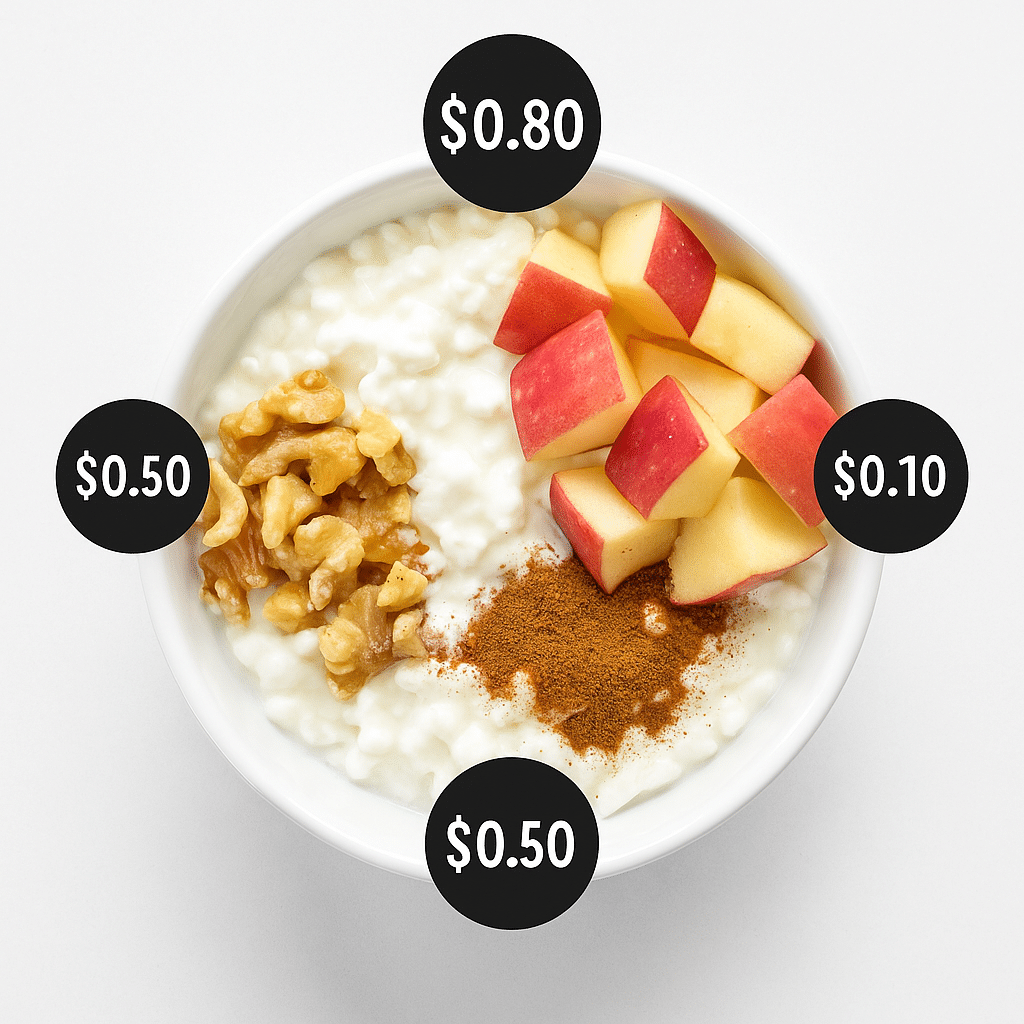
There you have it — six incredible ways to make your morning better with a protein-rich, flavorful cottage cheese breakfast bowl. Whether you’re team sweet or savory, on a budget, or meal prepping for the week ahead, there’s a bowl here for you!
So go ahead — pin your favorite flavor, prep ahead for the week, and enjoy breakfast like a boss.
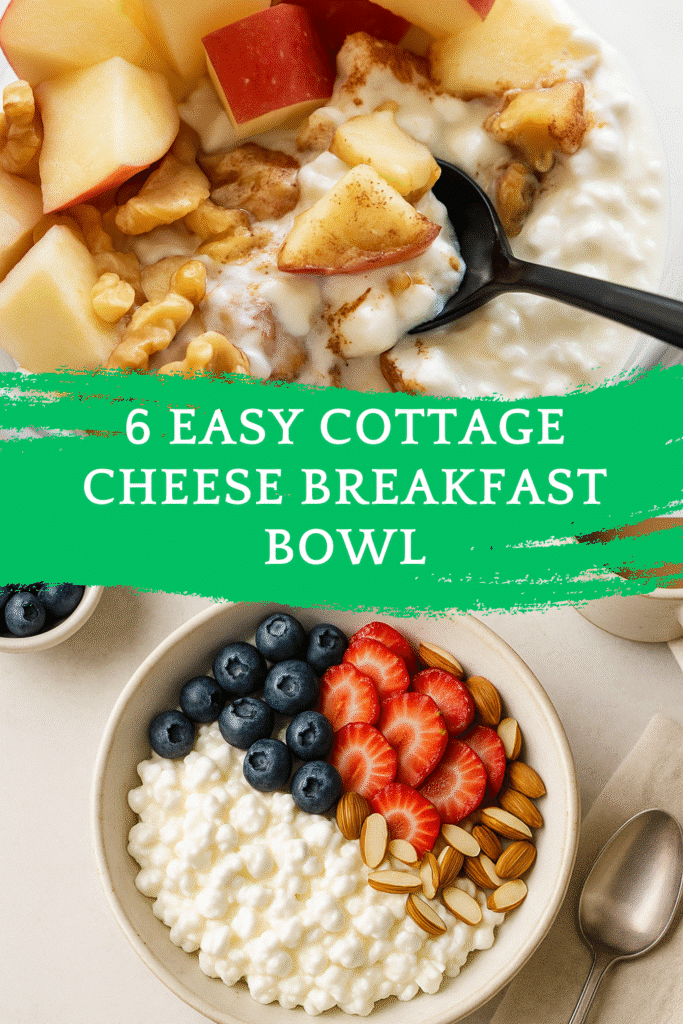
Frequently Asked Questions about Cottage Cheese Breakfast Bowl
How much cottage cheese should I use for a breakfast bowl?
Most people use between ½ to 1 cup of cottage cheese for a breakfast bowl. I usually go with ¾ cup — it’s the sweet spot for protein and satiety without feeling too heavy.
Can I prep cottage cheese breakfast bowls ahead of time?
Yes, but it’s best to store ingredients separately. Prep the cottage cheese in containers, and keep wet toppings like fruit or salsa in a separate container to avoid sogginess. Assemble fresh in the morning for best texture.
Is a cottage cheese breakfast bowl good for weight loss?
Absolutely. Cottage cheese is high in protein and low in carbs, which helps keep you full longer. Combine it with fiber-rich or healthy fat toppings to stay satisfied without excess calories.
Can I eat a cottage cheese breakfast bowl every day?
You can! Cottage cheese is a nutrient-dense food with protein, calcium, and B12. Just switch up your toppings to keep things balanced and avoid boredom.
What kind of cottage cheese is best?
I prefer 2% or full-fat cottage cheese for a creamier texture. Fat-free works if you’re cutting calories, but it’s a bit less satisfying and can taste dry.
Is a cottage cheese breakfast bowl okay for diabetics?
Yes, as long as you keep the carbs in check. Use low-glycemic toppings like nuts, cinnamon, and berries. Avoid honey, bananas, or sugary granola if you’re watching your blood sugar.
How long does a cottage cheese breakfast bowl last in the fridge?
Assembled bowls last about 1–2 days. If you store everything separately, your components can stay fresh for up to 5 days.
Can I freeze cottage cheese bowls?
Not really. Cottage cheese doesn’t freeze well — it gets watery and separates. Stick to refrigerating for short-term storage.
What are some savory ideas for a cottage cheese breakfast bowl?
Try toppings like avocado, boiled eggs, black beans, cherry tomatoes, or even salsa and green onions. Think of it like building a breakfast salad.
What containers are best for prepping cottage cheese breakfast bowls?
Use 8 oz glass jars with lids or divided meal prep containers to keep wet and dry toppings separate. This helps preserve texture and flavor.


